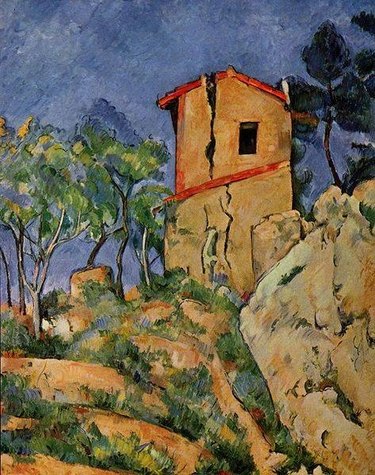
The focal point is the center of interest or activity in a work of art. It may or may not be the actual center of a painting or drawing, but it is always the most important part. Contrast, structure and color are three things that help define the focal point.
Contrast
Video of the Day
Our eyes are naturally drawn to contrast, the difference between dark and light, or dark and bright; it is the strongest attractor for the human eye. To create a focal point, many artists place the main subject in the area of highest contrast. For example, the house in "The House with Cracked Walls," an oil painting by Paul Cézanne, is the lightest object, and the window the darkest.
Video of the Day
Structure
The structure of an artwork influences where we look. The lines of the artwork should flow toward the focal point, leading our gaze to the most important feature. This can include the lines of architecture, rivers and roads, as well as the direction that objects, people or animals are facing within the artwork. The trees in "The House with Cracked Walls" all lean in toward the building, and the lines in the foreground draw our eyes up to the structure.
Color
Colors that appear opposite on the color wheel, known as complementary colors, create visual interest when placed side by side. Using complementary colors for any object in a painting draws attention to that object. Giving a bright orange-red roof to the building, against the slate blue of the clouds, draws focus to that building. In addition, warm colors (i.e., yellow, red, orange tones) seem to advance toward our eyes, while cool colors (i.e., blue, purple, green shades) recede.
Size
Size and location can create a focal point. We will usually focus on the largest object in a drawing or painting as the most important thing. The man-made structure is the largest single object in "The House with Cracked Walls." We also tend to look first at objects that are isolated, especially if the other objects in the picture are grouped together.
Shapes
Even in abstract art, we find focal points. Any element that stands out from the others draws our focus. A strong vertical line or shape among a field of horizontals becomes a focal point. An angular or geometric shape amid organic, flowing shapes grabs our attention. The building is the only object in "The House with Cracked Walls" that has straight lines -- the only man-made, inorganic thing.